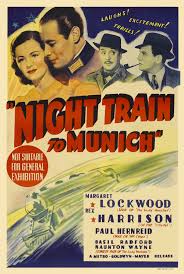
In 1939 Hitler invades Czechoslovakia. The country’s leading scientist, Dr. Axel Bomasch (James Harcourt) is sought by the Gestapo. Bomasch is the inventor of a new armor plating technique that the German’s are anxious to get their hands on. Bomasch manages to flee to England but his daughter, Anna (Margaret Lockwood), is captured and sent to a concentration camp.
At the camp, Anna meets another detainee, Karl Marsen (Paul Henreid). Marsen is really a Gestapo agent who is attempting to find out where Anna’s father is hiding. To gain Anna’s trust, Karl arranges for them to escape the camp and make their way to England. Through various contacts Anna is eventually sent to see a street musician named Gus Bennett (Rex Harrison). Gus’s real name is Dickie Randall, and he is a British agent. He reunites Anna with her father, but the Nazis are watching.
When the Nazis find out where Dr. Bomasch is hiding they devise a plan to capture Bomasch and his daughter and bring them to Germany to serve the Reich. Dickie must go undercover as a Nazi agent, Major Herzoff, to try to stop the Nazis before Bomasch and Anna reach Munich.
Karl becomes suspicious of Dickie and begins and investigation on him. When he learns that there is no such person as Major Herzoff, Karl plans on having Dickie arrested once the train they are on arrives in Munich. Dickie ends up relying on a couple British travelers, Caldicott (Naunton Wayne) and Charters (Basil Radford) to help him defeat Karl and his minions and free Bomasch and his daughter.
“Night Train To Munich” was released in 1940 and was directed by Carol Reed. It is a British espionage thriller. The film was based on a 1939 short story by Gordon Wellesley called “Report on a Fugitive”.
The film is quite often compared to “The Lady Vanishes” 1938 by Alfred Hitchcock. There are quite a few similarities, even the comic relief in the form of Naunton Wayne and Basil Radford reprising their roles as Caldicott and Charters.
There are a couple other areas that reminded me a little of Hitchcock’s film. Even the writers, Sidney Gilliat and Frank Launder, wrote both screenplays. Although they both have a similar feel, they have enough differences to make them both fun in their own way. I found the movie to be every bit as intriguing and captivating as if it were in Hitchcock’s hands.

